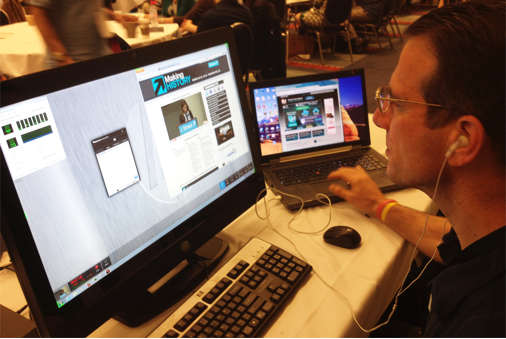Live from J Street, Part 1: Webcasting the National J Street Conference
During a 3-day gig as webcaster for J Street's Making History conference on Israeli-Palestinian relations, Jan Ozer learned a lot about the challenges of streaming events where you don't control critical factors like the set background and lighting. In part 1 of 3 on this project, Jan details the planning process and streaming setup.
I've produced multiple webcasts, but they've been primarily small events produced locally, usually as a volunteer or to provide a testbed for video switching or encoding-related projects. When I was contacted by Brendon Winters, a principal of Event Technology Partners, to help stream Making History, JStreet.org's third national conference in Washington, DC, I jumped at the chance (Figure 1, below).

Figure 1. Me, monitoring one of my sessions. Yes, I forgot my headphones, so had to get by with my earbuds.
By way of background, J Street is a pro-Israel, pro-peace organization for American Jews and other supporters of Israel. Though I am Jewish, I'm guessing Brendon didn't know that when he got in touch. For me, though, being Jewish and having been to Israel multiple times, it made sessions like What if Israel attacks Iran, and One-State, Two-State, Green State, Blue State, fascinating watching, particularly the intelligent and articulate Palestinian participants who erased the ghost of Yasser Arafat as the face of the Palestinian people for me. But I wasn't there to develop my personal ideology; I was there to stream some video.
Specifically, Brendon had contracted to stream eleven sessions held in two separate rooms over the three day convention, and then deliver full-resolution archives that J Street would convert to on-demand files for posting to YouTube. Most of the video work and projection was done by other companies; Brendon was in charge of streaming a feed provided by one of these companies in the main ballroom, and of shooting and streaming several high-profile sessions in a separate meeting room.
I was the final, and least experienced, team member. The other two were associates of Event Technology Partners, including shooter Manrico Zottig, who had great stories from his time travelling with Republican candidates Fred Thompson and Sarah Palin during the run up to the 2008 presidential election, and webcast guru Bern Rexer.
Over the three-day event, I learned a lot about shooting and streaming from these experienced pros, and a lot about the realities of streaming events where you don't control critical factors like the set background and lighting. I'll share these observations with you in three parts. For the rest of this installment, I'll detail the planning process and setup in each of the two rooms from which we streamed.
In Part 2, I'll discuss specific skills that I learned or reinforced during the event, including issues like the optimal framing for speakers on a panel, controlling audio volume during the event, and stream monitoring practices in general. In the final article, I'll detail the connections that we used between video gear and encoding stations and how we resolved sound-sync issues resulting from our initial setup. I'll also provide a quickie review of the new HP Z1 Workstation, which was the encoding station that I used during the event.
Pre-Conference Planning
Planning focused on issues like connectivity, the selection of the live streaming service provider, scheduling, and equipment. Brendon had the first issue resolved before I got involved, with dedicated on-site connectivity provided by Smart City Networks. Brendon had arranged for J Street to contract for 1.54 Mbps upload and download, though the actual connection, as tested by Speedtest.net, was closer to 3 Mbps upload and 1.5 Mbps download. This was shared between the two rooms from which we were broadcasting, which was acceptable only because we would never broadcast simultaneously.
If you're new to live event streaming, I can't make this point strongly enough: If you don't have sufficient and preferably dedicated connectivity, you don't have live streaming. Get pricing for connectivity before you submit your bid, and don't even think about using shared connectivity that may be available at the venue. For example, while the Washington Convention center itself offered free Wi-Fi, it averaged around 70 Kbps in both directions on the day of the event, just slightly higher than a 56 Kbps modem. We ultimately streamed at a combined data rate approaching 900 Kbps, which gave us plenty of headroom on the connection. Absent the dedicated connectivity that Brendon arranged for, we would not have been streaming.
Related Articles
In this final segment of this series on the JStreet Making History convention webcast, we'll examine one aspect of webcast production that too often gets ignored: monitoring and controlling audio volume, which becomes a complex issue as speakers change, audio techs and shooters adjust their own levels, and the webcaster is left to make sure the signal sent over the web remains audible and consistent.
HP's Z1 is the first all-in-one computer with workstation components and field serviceability. Here, encoding expert Jan Ozer takes a look at how this workstation-class portable PC fared in a live production and webcast environment, with testing emphasis in 3 areas: rendering, streaming encoding, and live encoding.
Jan Ozer passes on several key tips on framing panels and applying the rule of thirds (and when to break it) gleaned from his recent gig webcasting the national J Street conference on Israeli-Palestinian relations.